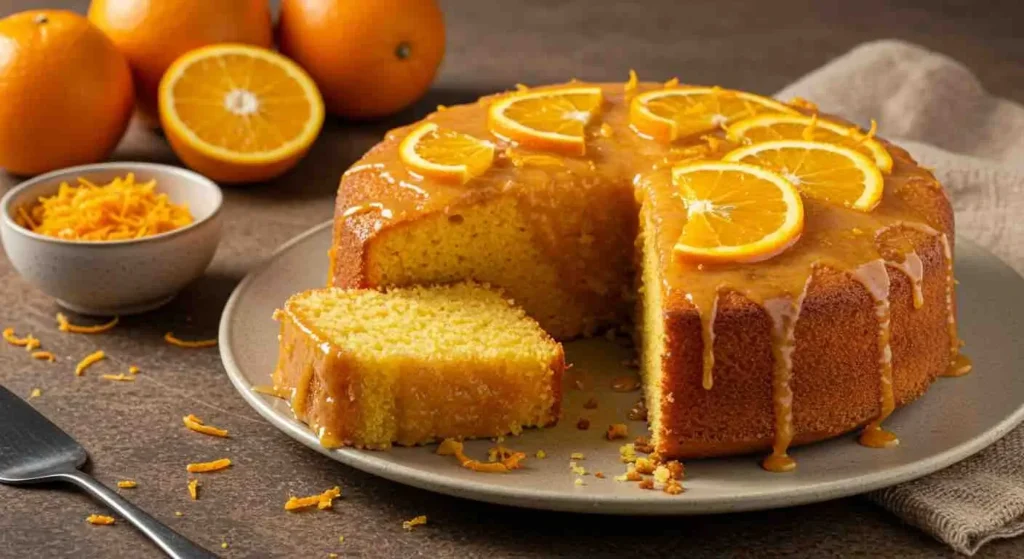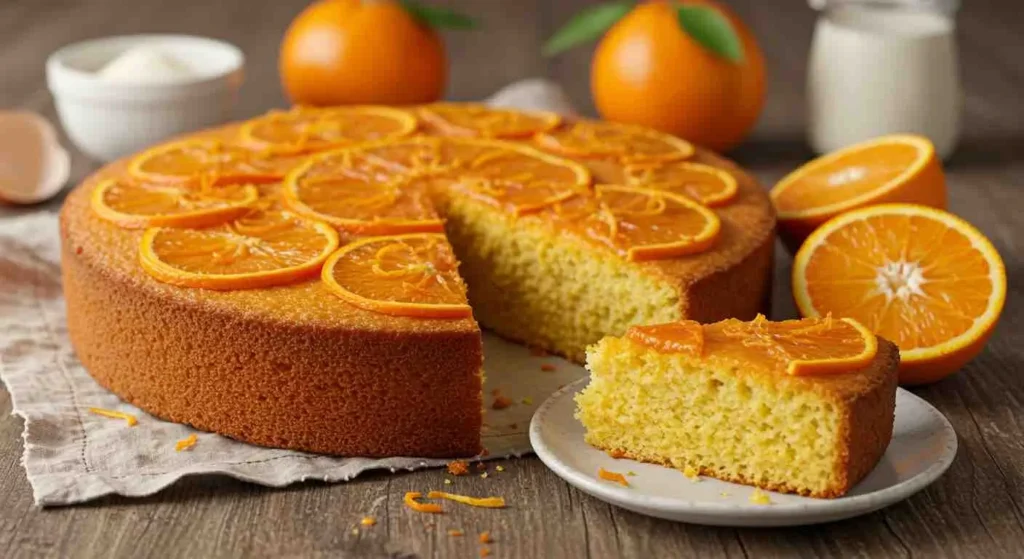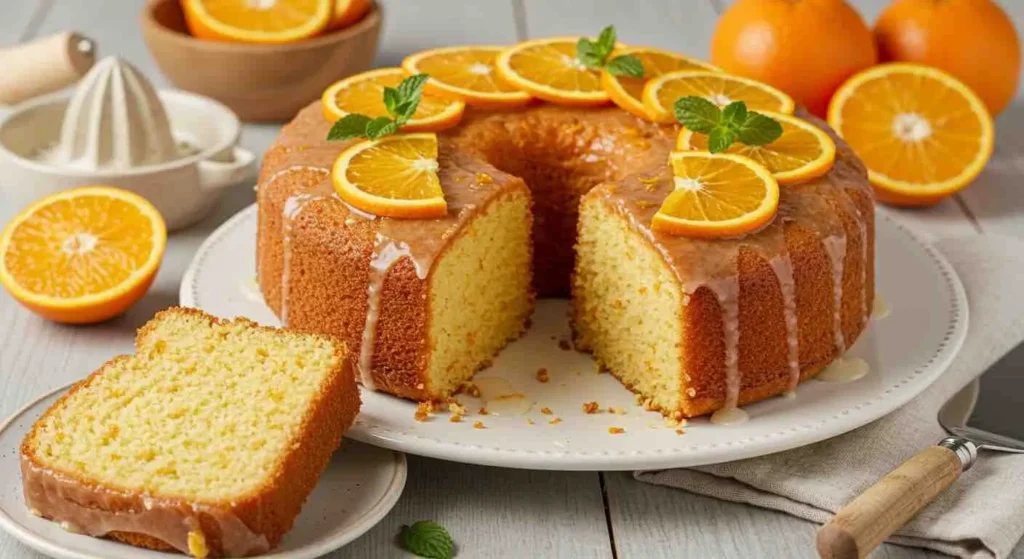Introduction:
There’s something undeniably uplifting about the scent of fresh oranges wafting through the kitchen. It’s like a burst of sunshine on a plate, and that’s precisely what a delicious orange cake offers—a light and fluffy citrus dessert that brightens any day.
Imagine biting into a slice of moist, tender cake infused with the vibrant flavor of oranges. The zest adds a fragrant aroma, while the juice imparts a tangy sweetness that dances on your taste buds. It’s a harmonious blend that transforms a simple cake into a delightful treat.
Creating this citrus masterpiece is more straightforward than you might think. With a few fresh ingredients and some basic baking techniques, you can whip up a dessert that’s both impressive and comforting. Whether you’re a seasoned baker or a novice in the kitchen, this orange cake recipe is designed to be foolproof and rewarding.
So, let’s embark on this flavorful journey together. We’ll explore the essential ingredients, step-by-step instructions, and some handy tips to ensure your orange cake turns out perfectly every time. Get ready to fill your home with the delightful aroma of citrus and enjoy a slice of sunshine with this delectable dessert.
Table of Contents
Imagine stepping into a kitchen filled with the fresh, zesty smell of oranges. It turns a simple baking session into a special experience that warms your heart. Making a homemade orange cake is more than just mixing ingredients. It’s about creating memories that stay with you long after the cake is gone.
The perfect orange cake recipe offers a mix of sweet and tangy flavors that delights your taste buds. Your citrus baking journey starts with learning the secrets behind this favorite dessert. With ingredients like fresh oranges, sugar, and the right amount of vegetable oil, you’ll make a moist and fluffy cake.
Whether you’re new to baking or have been doing it for years, this orange cake recipe will be your new favorite. We’ll show you how to pick the ripest oranges and master the baking technique. You’ll learn how to make a citrusy masterpiece that will wow your family and friends.
Get ready to improve your baking skills and see why homemade orange cake is a classic favorite. Your baking adventure begins right here!
Introduction to Citrus-Based Desserts
Citrus desserts have won the hearts of many in the United States. They add a fresh twist to baking, making ordinary recipes special. This turns simple baking into a memorable experience.
The world of citrus desserts is full of flavor and tradition. From tangy lemon bars to zesty orange cakes, they offer a unique taste. These desserts are more than just sweet treats.
History of Orange Cakes in American Baking
The history of orange cakes in America is fascinating. Citrus desserts gained popularity in the early 20th century. This was when fresh fruit became easier to find. Families would celebrate by making delicious orange-based treats, highlighting the fruit’s natural sweetness.
Benefits of Using Fresh Citrus in Desserts
- Fresh orange juice provides natural sweetness
- Orange zest benefits include intense flavor and aromatic qualities
- Citrus fruits offer natural preservative properties
- Enhances the nutritional value of desserts
Using fresh orange juice in baking has many benefits. It adds flavor and makes the cake moist and tender.
Why Orange Cake Stands Out Among Citrus Desserts
Orange cake is a highlight of unique orange cake flavors. It perfectly balances sweetness with citrus. Compared to other citrus cake options, orange cake is a favorite among both home bakers and professional chefs.
“A great orange cake is like sunshine on a plate – vibrant, uplifting, and impossible to resist.”

Essential Ingredients for Orange Cake
Making a perfect orange cake begins with the right ingredients. You need to pick high-quality items that blend well together. This is key to success in the kitchen.
- Flour: The cake’s base
- Sugar: Adds sweetness and helps with browning
- Baking powder: Essential for a light texture
- Eggs: Hold the cake together
- Fresh oranges: For juice and zest
- Olive oil: Brings moisture and flavor
Choosing the right oranges is critical. Fresh, ripe oranges make your cake taste better. Grate the orange zest before juicing to get the most citrus flavor.
Pro tip: Pick a fruity and mild olive oil to match the orange taste.
Make sure you have the right tools for measuring. Use two large eggs for the best binding. Adding a bit of cardamom can also add a unique flavor.
A simple orange glaze can make your cake look amazing. Mix 1 cup of confectioners’ sugar with orange juice until it’s the right consistency. This will give you a dessert that looks like it was made by a pro.
Kitchen Equipment and Tools Needed
To make the perfect orange cake, you need the right baking tools. Having the right cake pans, mixers, and measuring tools is key.
Baking Pans and Sizes
Choosing the right cake pans is important. Professional bakers suggest using:
- Three 8-inch cake pans
- Two 9-inch round cake pans
- A 9-inch springform pan with at least 2 inches of height
The right pans help your cake bake evenly and look great. Tip: Line your pans with parchment paper for easy removal.
Mixing Equipment Requirements
Your mixing tools are key to a great cake. You can choose from:
- Stand mixer: Offers consistent mixing and hands-free operation
- Hand mixer for cakes: Provides flexibility and is easy to carry
A good mixer is essential for the right batter.
Measurement Tools
Accurate measurements are vital for a successful orange cake. You’ll need:
- Digital kitchen scales for weight measurements
- Measuring cups for volume
- Measuring spoons
- Microplane grater for zesting oranges
Professional bakers say using gram measurements is best for consistent results.
Selecting and Preparing Fresh Oranges
Choosing the right oranges is key to a tasty citrus cake. The quality of your oranges affects the cake’s flavor and smell. Look for oranges that are firm, heavy, and have a bright, smooth skin.
Preparing oranges involves a few important steps. When zesting, only take the top layer of orange, avoiding the bitter white pith. A microplane grater is best for getting fine zest that adds a strong citrus taste to your cake.
- Select oranges with bright, smooth skin.
- Choose fruits that feel heavy and firm
- Avoid oranges with soft spots or blemishes
- Look for a sweet, citrusy aroma
For juicing, one medium orange gives about ¼ cup (60 ml) of fresh juice. Bakers say using fresh juice makes the cake taste more vibrant. Try to use oranges at room temperature for more juice.
| Orange Selection Criteria | Optimal Characteristics |
|---|---|
| Skin Condition | Bright, smooth, no blemishes |
| Weight | Heavy for its size |
| Juice Yield | ¼ cup per medium orange |
| Zesting Technique | Grate only the top orange layer |
For better zest, rub it into sugar. This releases oils, making the cake taste better. Remember, using fresh, quality oranges makes your cake stand out.

Orange Cake Base Recipe
Making the perfect orange cake needs careful mixing and knowing how ingredients work together. Success comes from preparing dry and wet ingredients well. This makes your dessert light and full of flavor.
Preparing the Flour Mixture
Begin with your dry ingredients. You’ll sift together 2¼ cups of all-purpose flour, ⅓ cup cornstarch, 2¼ teaspoons baking powder, and ½ teaspoon salt. Sifting removes lumps and makes the flour mix evenly. This helps your cake be smooth.
Wet Ingredients Technique
For the wet ingredients, mix ¾ cup unsalted butter, ⅓ cup vegetable oil, 1¼ cups white sugar, and 3 teaspoons orange zest. Then, add 3 large eggs, 5½ tablespoons milk, ½ cup fresh orange juice, and 2 teaspoons vanilla extract10.
Combining Cake Batter
When combining, be gentle. Add your dry ingredients to the wet mix slowly. Mix just until they’re combined. Avoid overmixing to keep the cake light and tender.
- Sift dry ingredients thoroughly.
- Cream wet ingredients until smooth
- Fold gently to maintain air bubbles
- Mix just until ingredients are incorporated
“Gentle folding is the secret to a perfectly light orange cake.”
By using these techniques, you’ll make a delicious orange cake. It will have great texture and taste.
The Perfect Orange Cream Cheese Frosting
Making a cream cheese frosting with a zesty orange flavor can take your cake to the next level. The secret is to mix the tangy cream cheese with fresh citrus notes.
- 6 ounces softened cream cheese
- 3 tablespoons room-temperature butter
- 3/4 cup powdered sugar
- 1 1/2 teaspoons orange zest
- 1 teaspoon fresh orange juice
This recipe makes about 1 1/2 cups of frosting. It’s just right for 12 cupcakes or one 9-inch round cake. And the best part? It only takes 10 minutes to make.
“The secret to an amazing frosting is balancing flavors and achieving the right consistency.” – Professional Pastry Chef
Here’s what you get in each tablespoon of this tasty frosting:
| Nutrient | Amount |
|---|---|
| Calories | 20 kcal |
| Carbohydrates | 5 g |
| Protein | 1 g |
| Fat | 1 g |
For storing leftovers, refrigerate them for up to 5 days. But remember, this frosting doesn’t freeze well because of the cream cheese.
Pro tip: Make sure all your ingredients are at room temperature. This will help your frosting be smooth and easy to spread!
Baking Techniques for Moisture and Fluffiness
To make the perfect orange cake, you need to master a few baking techniques. These ensure your cake is moist and fluffy. The key is knowing how to control oven temperature, baking time, and checking for cake doneness.
Temperature Control for Perfect Baking
Your oven’s temperature is very important for a tasty orange cake. Most recipes say to bake at 350°F (175°C) for 30-35 minutes. Some suggest baking for 40-45 minutes, depending on your oven13.
- Preheat the oven completely before placing the cake inside
- Use an oven thermometer to verify accurate temperature
- Place the cake in the center rack for even heat distribution
Mastering the Toothpick Test
The toothpick test is the best way to check if your cake is done. Stick a clean toothpick into the cake’s center. It should come out clean or with a few moist crumbs. If it’s wet, bake for another 5 minutes.
Pro tip: Avoid opening the oven door too frequently, as this can cause temperature fluctuations and affect your cake’s texture.
For the best results, aim for an internal cake temperature of 200-209°F. This keeps your orange cake moist and fully baked.
Remember, baking takes patience. With the right oven temperature and careful doneness testing, you’ll get a fluffy and delicious orange cake13.
Decorating Your Orange Cake
Cake decoration turns your orange cake into a stunning masterpiece. Your orange cake garnish can make it visually appealing and memorable for all who taste it.
- Dust with powdered sugar for a classic, elegant finish
- Garnish with fresh orange zest sprinkled across the top
- Create detailed designs using candied orange slices
- Pipe delicate cream cheese frosting patterns
For a professional orange cake garnish, follow these tips:
- Use a fine-mesh sieve for even powdered sugar distribution
- Cut candied orange slices uniformly for a polished look
- Chill your cake before decorating to ensure crisp designs
*”The art of cake decoration is about creativity and personal expression”*
Your orange cake’s look can reflect your unique baking style. Whether you like simple elegance or detailed designs, these methods will make your dessert a hit.
Storage and Freshness Tips
Keeping your orange cake fresh is key. Knowing how to store it right ensures you enjoy every bite. The right storage methods make all the difference.
Room Temperature Storage
Your orange cake stays fresh at room temperature for a few days. An unfrosted cake keeps well for up to 3 days in an airtight container. To keep it moist, cover it loosely with plastic wrap or use a cake keeper.
Refrigeration Guidelines
When it comes to cream cheese frosting, refrigeration is a must. Here’s how to keep your cake fresh in the fridge:
- Wrap the cake tightly in plastic wrap
- Store in an airtight container
- Bring to room temperature before serving
- Consume within 5-7 days
Freezing Instructions
Freezing is great for long-term storage. A wrapped cake can last up to 2 months in the freezer. Here’s how to freeze your cake:
- Cool the cake completely
- Wrap tightly in plastic wrap
- Add a layer of aluminum foil
- Label with the date
- Thaw at room temperature when ready to serve
Pro tip: Always thaw frozen cakes slowly to keep them moist and flavorful.
Common Troubleshooting Solutions
Baking the perfect orange cake can be tough. But knowing common problems and solutions can make it easier. Let’s look at the most common issues and how to fix them.
Preventing Cake Disasters
Cake problems come from many sources. 75% of bakers struggle with cakes sticking to the pan. Here are some tips to avoid these issues:
- Make sure to grease the pan well
- Use parchment paper for easy cake removal
- Let the cake cool before taking it out of the pan
Addressing Dry Cake Challenges
60% of bakers face dry cake as a major problem. The main reasons include:
- Incorrect flour measurement
- Wrong liquid amounts
- Overmixing the batter
“Precision is key in creating a moist and delightful orange cake.”
To avoid dry cakes, focus on accurate measurements and mixing. Choosing the right pan size and keeping the oven at the right temperature are also key.
| Cake Problem | Potential Solution |
|---|---|
| Sinking Center | Avoid opening the oven during baking |
| Dry Texture | Measure ingredients precisely |
| Uneven Baking | Use an oven thermometer for accuracy |
Remember, only 15% of bakers use timers when baking. Keeping an eye on your cake can prevent overbaking and ensure success every time.

Variations and Flavor Enhancements
Exploring orange cake variations lets you turn a classic into something special. You can make this citrus dessert even better by trying out new flavors. These can enhance the bright orange taste.
- Nutty Additions: Add chopped almonds or walnuts for extra texture
- Spice Infusions: Mix in cinnamon or cardamom for a warm twist
- Liqueur Enhancements: Use orange vodka or Galliano for a deeper flavor
Using different oranges can change your cake’s taste. Cara Cara oranges add a sweet touch, while blood oranges bring a deeper citrus flavor.
| Flavor Addition | Recommended Quantity | Impact on Cake |
|---|---|---|
| Vanilla Extract | 2 teaspoons | Enhances overall sweetness |
| Fiori di Sicilia | 1/2 teaspoon | Adds complex citrus aroma |
| Almond Extract | 1/4 teaspoon | Introduces nutty undertones |
Pro tip: Always start with small quantities of flavor additions to maintain the cake’s delicate orange essence.
Your orange cake can be a blank canvas for creativity. Try out different variations to find your favorite citrus dessert!
Serving Suggestions and Pairings
Make your orange cake special with creative drinks and stunning presentation. The right drink can turn a simple dessert into a memorable moment.
Perfect Beverage Combinations
Finding the perfect drink for your orange cake is key. Here are some top pairings:
- Espresso or dark roast coffee
- Earl Grey tea
- Dessert wines like Moscato
- Citrus-infused cocktails
- Sparkling white wine
Artistic Cake Plating
Make your orange cake look amazing with these plating tips:
- Dust the plate with powdered sugar
- Add fresh orange segments as garnish
- Drizzle chocolate or caramel sauce
- Incorporate edible flowers
| Pairing Type | Recommended Options | Flavor Profile |
|---|---|---|
| Hot Beverages | Cappuccino, Herbal Tea | Complementary Citrus Notes |
| Cold Drinks | Orange Liqueur, Prosecco | Refreshing Citrus Burst |
| Dessert Wines | Late Harvest Riesling | Sweet Harmonious Blend |
The orange and chocolate combo is a decadent match that can make your dessert unforgettable22. Try different presentations to find your favorite.
Conclusion
Your orange cake recipe journey is a fun adventure in baking. It shows how to make a beautiful citrus dessert with fresh oranges. The recipe summary stresses the need for quality ingredients and careful preparation.
Choosing ripe oranges and finding the right baking temperature are key steps. Each detail makes your dessert stand out. Using fresh orange juice and zest boosts the cake’s taste. Even beginners can make amazing cakes with practice and patience.
Your homemade orange cake is more than a treat—it’s a celebration of cooking. It’s perfect for special events or a cozy afternoon tea. Enjoy baking and share your tasty cake with friends and family.
FAQ
How do I know which oranges are best for baking an orange cake?
Pick oranges that are fresh and ripe. Look for ones with bright color and firm skin. Navel or Valencia oranges are great choices because they have good juice and zest.
Choose oranges that feel heavy and smell sweet. Avoid oranges with soft spots or dull skin, as they might be too ripe.
Can I make an orange cake without an electric mixer?
Yes, you can make an orange cake by hand. Use a manual whisk or a wooden spoon. It might take more effort, but it works.
The key is to mix well but gently. This helps avoid a tough cake.
How long can I store an orange cake?
At room temperature, a covered orange cake stays fresh for 2-3 days. If you refrigerate it, it can last up to 5-7 days, thanks to the cream cheese frosting.
To store it longer, freeze the cake (unfrosted) for up to 3 months. Wrap it tightly in plastic wrap and aluminum foil.
Why did my orange cake turn out dry?
Dry cakes can happen for a few reasons. They might be overbaked, have too much flour, or not enough liquid. Or, you might have mixed the batter too much.
To avoid dryness, use the right amounts of ingredients. Check the cake a few minutes before it’s done. And use fresh, moist ingredients like sour cream or buttermilk.
Can I substitute bottled orange juice for fresh juice?
Bottled orange juice is okay if you don’t have fresh. But fresh juice tastes better. It has more citrus flavor and natural sweetness.
If you use bottled juice, pick 100% pure orange juice without added sugars or preservatives.
Is it necessary to use cream cheese frosting?
No, you don’t need cream cheese frosting. You can use vanilla buttercream, glaze, or powdered sugar instead. The cream cheese frosting just adds a special touch.
How can I add more orange flavor to my cake?
To make your cake more orangey, use fresh orange zest. Add a bit of orange extract or brush the cake with orange simple syrup.
You can also add orange liqueur to the batter or frosting for a stronger citrus taste.
What’s the best pan for baking an orange cake?
Use a 9-inch round cake pan or a bundt pan for orange cake. Choose a light-colored, heavy pan for even heat. Non-stick pans are good, but grease and flour them well for easy cake removal.
Can I make this cake gluten-free?
Yes, you can make a gluten-free orange cake. Use a gluten-free flour blend that includes xanthan gum. This helps it taste like traditional wheat flour. Just be sure to measure carefully and follow the blend’s instructions.
How do I prevent my cake from sinking in the middle?
To stop your cake from sinking, don’t overmix the batter. Make sure your leavening agents are fresh. And don’t open the oven door too early.
Measure your ingredients carefully and bake at the right temperature. This helps the cake rise evenly.

